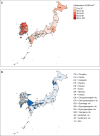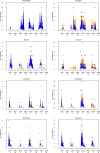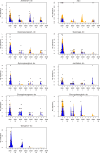Prediction models show differences in highly pathogenic avian influenza outbreaks in Japan and South Korea compared to Europe
- PMID: 40000899
- PMCID: PMC11862228
- DOI: 10.1038/s41598-025-91384-3
Prediction models show differences in highly pathogenic avian influenza outbreaks in Japan and South Korea compared to Europe
Abstract
Avian influenza poses substantial risks to animal welfare and public health. The recent surge in highly pathogenic avian influenza (HPAI) outbreaks has led to extensive poultry culling, highlighting the need for early warning systems. Using data on H5 HPAI virus (HPAIV) occurrence from the World Organization for Animal Health and the Food and Agriculture Organization, we employed a spatial time-series modelling framework to predict occurrences in Japan and South Korea, 2020-2024. This framework decomposes time-series data into endemic and epidemic components and has previously been used to model HPAIV in Europe. We identified 1,310 HPAIV detections from 2020 to 2024, the majority being H5N1 (55.3%) and H5N8 (35.0%). These data consisted of 827 and 483 detections in wild and domestic birds, respectively. The model included seasonality and covariates in both endemic and epidemic components and revealed consistent yearly seasonal patterns. This contrasts with previous modelling of European data where seasonality changed over time. The model predicted 81% of detections as epidemic, primarily due to within-region transmission (53%), whereas only 19% were endemic. This model effectively predicts weekly H5 HPAIV detections, aiding decision-makers in identifying high-risk periods. This study confirms the robustness and usefulness of endemic-epidemic modelling of HPAIV in different regions of the world.
Keywords: Asia; Disease occurrence; Early-warning modelling; Endemic-epidemic modelling; Highly pathogenic avian influenza; Wild and domestic birds.
© 2025. The Author(s).
Conflict of interest statement
Declarations. Competing interests: The authors declare no competing interests.
Figures






Similar articles
-
The genetics of highly pathogenic avian influenza viruses of subtype H5 in Germany, 2006-2020.Transbound Emerg Dis. 2021 May;68(3):1136-1150. doi: 10.1111/tbed.13843. Epub 2020 Sep 29. Transbound Emerg Dis. 2021. PMID: 32964686 Review.
-
Phylogenetic Analysis of H5N8 Highly Pathogenic Avian Influenza Viruses in Ukraine, 2016-2017.Vector Borne Zoonotic Dis. 2021 Dec;21(12):979-988. doi: 10.1089/vbz.2021.0031. Vector Borne Zoonotic Dis. 2021. PMID: 34958264 Free PMC article.
-
The episodic resurgence of highly pathogenic avian influenza H5 virus.Nature. 2023 Oct;622(7984):810-817. doi: 10.1038/s41586-023-06631-2. Epub 2023 Oct 18. Nature. 2023. PMID: 37853121
-
Emergence and spread of highly pathogenic avian influenza A(H5N8) in Europe in 2016-2017.Transbound Emerg Dis. 2018 Oct;65(5):1217-1226. doi: 10.1111/tbed.12861. Epub 2018 Mar 14. Transbound Emerg Dis. 2018. PMID: 29536643
-
Evolution, global spread, and pathogenicity of highly pathogenic avian influenza H5Nx clade 2.3.4.4.J Vet Sci. 2017 Aug 31;18(S1):269-280. doi: 10.4142/jvs.2017.18.S1.269. J Vet Sci. 2017. PMID: 28859267 Free PMC article. Review.
Cited by
-
Highly pathogenic avian influenza: pandemic preparedness for a scenario of high lethality with no vaccines.Front Public Health. 2025 Jul 16;13:1613869. doi: 10.3389/fpubh.2025.1613869. eCollection 2025. Front Public Health. 2025. PMID: 40740369 Free PMC article.
References
-
- WAHIS: World Animal Health Information System (of the OIE). wahis.woah.org/#/home (2024).
-
- Harvey, J. A., Mullinax, J. M., Runge, M. C. & Prosser, D. J. The changing dynamics of highly pathogenic avian influenza H5N1: Next steps for management & science in North America. Biol. Conserv.282, 110041 (2023).
MeSH terms
LinkOut - more resources
Full Text Sources
Medical

